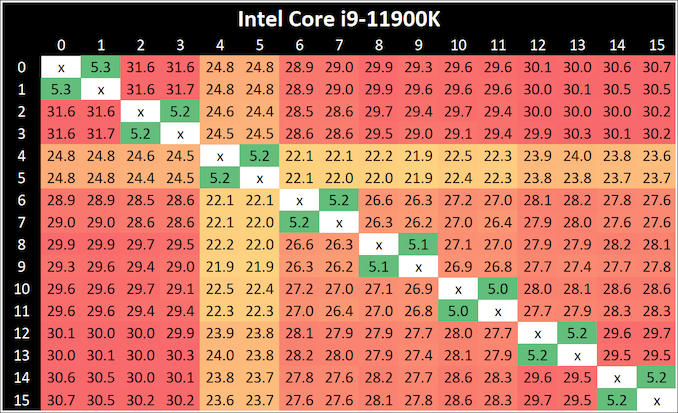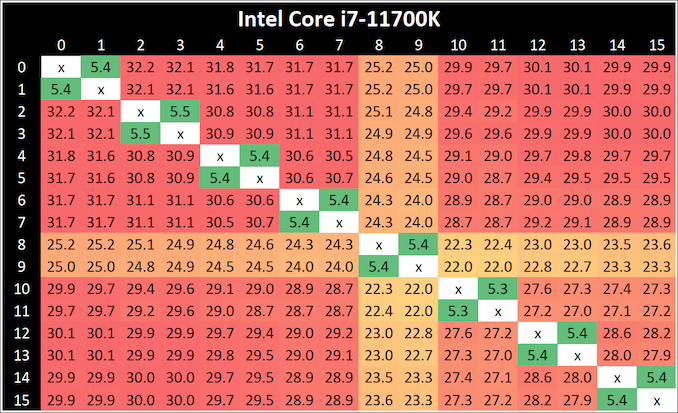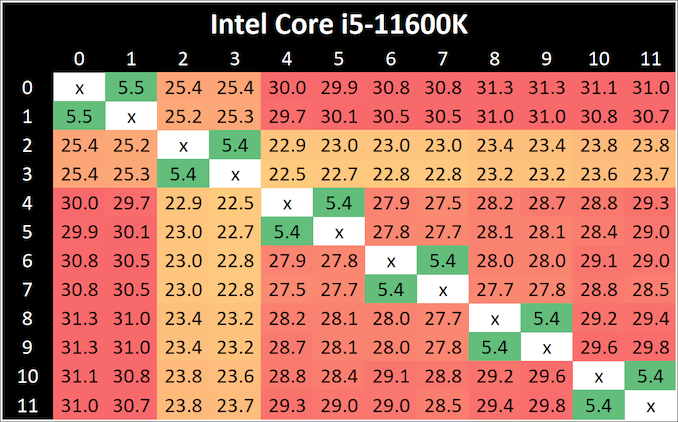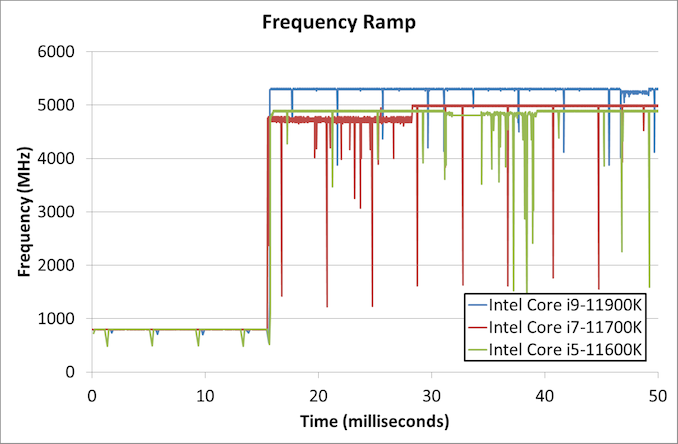Intel Rocket Lake (14nm) Review: Core i9-11900K, Core i7-11700K, and Core i5-11600K
by Dr. Ian Cutress on March 30, 2021 10:03 AM EST- Posted in
- CPUs
- Intel
- LGA1200
- 11th Gen
- Rocket Lake
- Z590
- B560
- Core i9-11900K
CPU Tests: Microbenchmarks
Core-to-Core Latency
As the core count of modern CPUs is growing, we are reaching a time when the time to access each core from a different core is no longer a constant. Even before the advent of heterogeneous SoC designs, processors built on large rings or meshes can have different latencies to access the nearest core compared to the furthest core. This rings true especially in multi-socket server environments.
But modern CPUs, even desktop and consumer CPUs, can have variable access latency to get to another core. For example, in the first generation Threadripper CPUs, we had four chips on the package, each with 8 threads, and each with a different core-to-core latency depending on if it was on-die or off-die. This gets more complex with products like Lakefield, which has two different communication buses depending on which core is talking to which.
If you are a regular reader of AnandTech’s CPU reviews, you will recognize our Core-to-Core latency test. It’s a great way to show exactly how groups of cores are laid out on the silicon. This is a custom in-house test built by Andrei, and we know there are competing tests out there, but we feel ours is the most accurate to how quick an access between two cores can happen.
All three CPUs exhibit the same behaviour - one core seems to be given high priority, while the rest are not.
Frequency Ramping
Both AMD and Intel over the past few years have introduced features to their processors that speed up the time from when a CPU moves from idle into a high powered state. The effect of this means that users can get peak performance quicker, but the biggest knock-on effect for this is with battery life in mobile devices, especially if a system can turbo up quick and turbo down quick, ensuring that it stays in the lowest and most efficient power state for as long as possible.
Intel’s technology is called SpeedShift, although SpeedShift was not enabled until Skylake.
One of the issues though with this technology is that sometimes the adjustments in frequency can be so fast, software cannot detect them. If the frequency is changing on the order of microseconds, but your software is only probing frequency in milliseconds (or seconds), then quick changes will be missed. Not only that, as an observer probing the frequency, you could be affecting the actual turbo performance. When the CPU is changing frequency, it essentially has to pause all compute while it aligns the frequency rate of the whole core.
We wrote an extensive review analysis piece on this, called ‘Reaching for Turbo: Aligning Perception with AMD’s Frequency Metrics’, due to an issue where users were not observing the peak turbo speeds for AMD’s processors.
We got around the issue by making the frequency probing the workload causing the turbo. The software is able to detect frequency adjustments on a microsecond scale, so we can see how well a system can get to those boost frequencies. Our Frequency Ramp tool has already been in use in a number of reviews.
From an idle frequency of 800 MHz, It takes ~16 ms for Intel to boost to the top frequency for both the i9 and the i5. The i7 was most of the way there, but took an addition 10 ms or so.














279 Comments
View All Comments
schujj07 - Wednesday, March 31, 2021 - link
Intel 10nm is not TSMC 7nm.watzupken - Wednesday, March 31, 2021 - link
"What the he'll is that supposed to mean that you can't you can't get the frequency at 10 nm and therefore you have to stick with the 14 nm node? That's pure nonsense, AND is at 7 nm and they are getting the target frequencies. Maybe stop spreading the Coolaid and call a spade a spade...."I am not sure how true this is, but the clockspeed for early versions of 10nm were abysmal. If you look at the first gen of 10nm chip from Intel, Cannon Lake, not just is clockspeed low, but specs is bad. Second gen 10nm, Ice Lake, and you see similar trend of very low clockspeed. I am using an i5 Ice Lake U that is advertised with a base clock of 1Ghz. It is only with 10nm Super Fin (third gen) where you start seeing higher clockspeed. Also, yield with early 10nm is certainly an issue, or they will not have to push out Rocket Lake @ 14nm, while laptops and servers/ workstations (only recently) are on 10nm. I suspect Intel is pushing their 10nm towards the same path as their current 14nm, feed it with more power and push clockspeed as high as possible. I will not be surprise that Alder Lake may bring better performance with a max of 8 big cores, but power consumption wise may only see marginal improvements at load. Light load may not expose the power inefficiency because of the small cores will pick up the load.
boozed - Tuesday, March 30, 2021 - link
There's some weirdness going on in at least one, possibly two of the FFXV 95th percentile graphswatzupken - Wednesday, March 31, 2021 - link
I feel I have to give Intel the credit of moving forward with a 14nm Rocket Lake, instead of hanging around like they did for the last 5 years with the same Skylake chip but boosted with steroids. But evidently, 14nm is becoming a burden to their progress. I know Intel supporters will claim that 14nm is capable of competing with 7nm. On the surface, yes. But at the cost of massive power draw and heat output with regression in performance as compared to the previous i9 in some cases. I would say that i5 would still be a chip worth considering, but not the i7 or i9 if you your main use case is gaming. At the respective price points, looking just at the price of an Intel i7 or i9 Rocket Lake chip appears to be cheap, but if you consider you need some hardcore motherboard and cooling to keep the chip chugging at the a high all core clockspeed, the cost actually skyrockets.Personally after looking at a number of reviews of Rocket Lake, it seems to me its a product that is too little and too late. Plus, if you are going for an i7 or i9, your upgrade path is dead since there will be no Rocket Lake with a higher core count. At least on the AMD camp, if you settled for a Ryzen 5 or 7, one may still have the option to scoop up a Ryzen 9 if prices come down with the introduction of Zen 4. In the absence of AMD chips at MSRP, I guess I will only recommend a Rocket Lake i5 because of the significant improvement over last gen. Otherwise, I don't think most will lose out much by going for the discounted Comet Lake chips.
Hifihedgehog - Wednesday, March 31, 2021 - link
LOL. Keep dreaming...https://i.imgflip.com/53vqce.jpg
529th - Wednesday, March 31, 2021 - link
No chipset fans for their PCIe 4.0?JMC2000 - Wednesday, March 31, 2021 - link
Intel 500-series chipsets don't have PCI-E 4.0, only the CPU does.https://ark.intel.com/content/www/us/en/ark/produc...
yeeeeman - Wednesday, March 31, 2021 - link
One of the few tech sites that remained professional and didn't use click baity titles or disrespect intel.Rocket is clearly a stop gap and a product that doesn't make sense, but it is what it is and as a professional tech writer you should treat it with decency not write insulting words and call it a poop like hardware unboxed did for example.
XabanakFanatik - Wednesday, March 31, 2021 - link
Ok PiednoelQasar - Wednesday, March 31, 2021 - link
go see how well gamers nexus liked this cpu.intel deserves ALL the flack they get for this cpu, its a joke, and a dud.